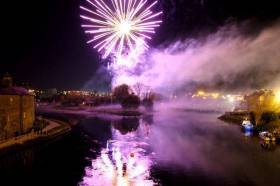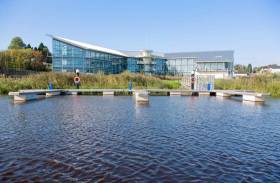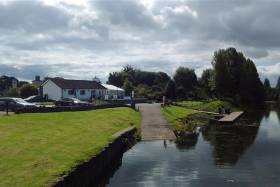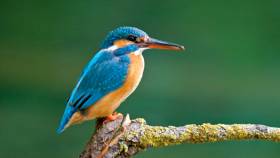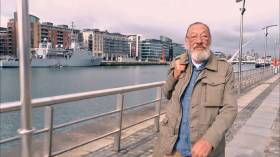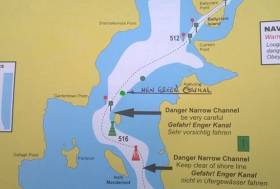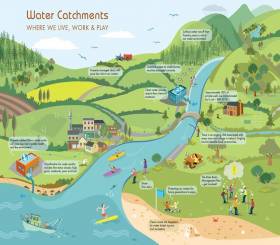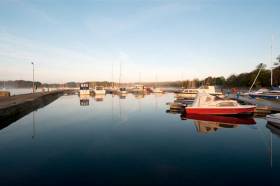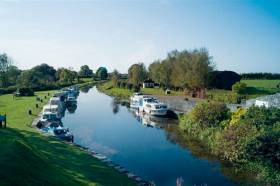Displaying items by tag: inland waters
Fireworks & Flotilla In Enniskillen For Hallowe’en Night
#InlandWaters - Waterways Ireland advises all masters and users of the Erne Navigation that a fireworks display will take place at Castle Island in Enniskillen on Hallowe’en night (Tuesday 31 October) from 8pm to 8.30pm.
Boat masters should also be aware of an event called Light Up the Lough which will take place prior to the fireworks display from 6.30pm.
Light Up the Lough is a flotilla of lit-up vessels from Erne Paddlers, Row the Erne and Erne Boat Hire Ltd. The boats will be dressed in lights and will circle around Castle Island four an hour.
Passing vessels must keep wash to a minimum and stay clear of this activity.
Masters of vessels are advised that there will be no mooring permitted at Waterways Ireland Head Office moorings nor at the Henry Street Public Jetties on the day of the event in the interest of public safety.
Navigation in the vicinity of Castle Island is also prohibited for the duration of the event.
Alternative moorings are available at the Forum and Regal Pass jetties with easy access to event vantage points.
Instructions from safety vessels must be adhered to at all times.
Further information may be had from the Lough Erne Manager/Warden at Waterways Ireland Head Office at 0044 48 66322836.
Waterways Ireland Archive Open To Visitors This Weekend
#InlandWaters - The Waterways Ireland Archive in Enniskillen is open for tours today and tomorrow (Saturday 9 and Sunday 10 September) as part of the European Heritage Open Days taking place across Northern Ireland this weekend.
From 1pm to 5pm today and tomorrow, visitors can dive into the archives to discover the history of the inland waterways, and explore original archive material.
You'll also get a free tour of the building (tours start at 1pm, 2pm, 3pm and 4pm) which will include the chance to see the solo exhibition ‘Elsewhere’ by artist Douglas Hutton, showcased as part of the Fermanagh Live arts festival.
The exhibition will remain open to the public from 7pm in the evening throughout the festival until Saturday 30 September.
Rise In Fish Kills Recorded In EPA Water Quality Report Disappointing Says Fisheries Agency
#FishKill - Inland Fisheries Ireland (IFI) has expressed disappointment at the findings of the Environmental Protection Agency (EPA)’s water quality review.
According to the EPA report, published yesterday (Thursday 31 August), the total number of reported fish kills in 2013–2015 was 97 — an increase in fish kills compared to 2007–2009 and 2010–2012.
In several instances of fish kills, the exact cause was unknown and several influences may have played a part.
IFI has cautioned against singling out any particular sector for the standard in water quality across Ireland’s river basins and lakes, backing the EPA’s findings that “multiple factors” are at play.
“There were 31 separate fish kills across the country last year, but just eight of those were directly attributable to agricultural activities,” said IFI chief executive Dr Ciaran Byrne.
“Inland Fisheries Ireland is grateful to the farming community for their continued consideration and vigilance. Good farmyard management can help to prevent accidental runs of polluting substances and protect the local environment.”
In addition to the agricultural-related kills, two fish kills were as a result of municipal works and one by industrial works.
In four instances, the exact cause of the fish kill was difficult to ascertain while 16 incidents of fish kills were as a result of disease and natural causes.
IFI carried out over 22,000 environmental inspections in 2016 across industrial, forestry, engineering, water treatment, farmyards and wind farms sites to help identify any risks and prevent damage to the local aquatic habitat.
“From an ecological and angling tourism perspective, our rivers and lakes are vital national resources,” said Dr Byrne. “It is essential that we protect and conserve these assets and water quality has a significant impact on fisheries habitats and populations.”
Toome Waterways Heritage Centre & Café Now Open
#InlandWaters - Toome-based development group Tidal Ltd has officially opened a new waterways heritage centre and café on the site of the former lockkeeper’s cottage on the Toome Canal in Co Antrim.
Working with Lough Neagh Landscape Partnership and Waterways Ireland, the group secured funding from the Heritage Lottery Fund through its Landscape Partnership Fund to undertake regeneration and refurbishment of the cottage, quay and wider canal amenity area.
The new centre houses a comprehensive interpretative display that covers the history of the canal and its importance as a gateway linking the North Coast to Lough Neagh as well as information on the community, natural environmental and wider cultural and industrial heritage of the site.
Speaking at the launch, Tidal chairman John Laverty outlined the benefits the new project will bring to the area.
“We at Tidal are delighted to have been instrumental in achieving the realisation of this wonderful new facility. From a cultural, educational, leisure, tourism and historical perspective, we see this reinvention of the disused lockkeeper’s cottage as something which will further enrich the tapestry of Toome,” he said.
Conor Jordan, chair of Lough Neagh Partnership and the Landscape Partnership Forum, complemented all involved in the development and delivery of the Waterways Heritage Centre and Café.
“This is an excellent example of how partnership working across the voluntary and statutory sectors can lead to the delivery of a new facility that helps promote a greater understanding of our landscape heritage whilst contributing to both the social and economic development of the wider lough,” he said.
Jim McGreevy, Heritage Lottery Fund NI committee member, added: “Landscapes are more than just beautiful scenery, they are also living, working places, full of stories and experiences. This new facility will give visitors an insight into past life in and around Lough Neagh and we wish the Partnership every success with this new project.
“HLF’s Landscape Partnership programme encourages a mix of projects and activities which not only help to protect the landscape but also to give communities the opportunities to explore and share their heritage with others. We are delighted that National Lottery players’ money will help Lough Neagh’s communities celebrate the wonderful heritage on their doorsteps.”
Waterways Ireland chief executive Dawn Livingstone praised the success of the partnership between the groups at Toome to bring this project to fruition.
“Waterways Ireland, as the custodian of a number of unique heritage buildings along the waterways, welcomes opportunities to work alongside partners to give these historic buildings a modern and useful purpose,” she said. “Today we see the outcome of one of these working partnerships with the beautiful restoration of this lockhouse to provide a hub for the community and an attraction for tourists to the River Bann and Lough Neagh.”
The new centre and café will be open Monday to Saturday from 9am to 5pm and will be available for both organised group visits and day trippers.
This is one of 27 integrated Heritage Lottery Fund landscape programme projects which aim to protect the built, cultural and natural heritage of the lough being delivered by Lough Neagh Landscape Partnership.
#InlandWaters - BirdWatch Ireland is appealing to users of Ireland’s inland waterways to get involved in its survey of river birds in man-made structures.
Ireland supports a rich and diverse network of rivers, canals and other waterways. Though often difficult to access, these sites are regularly visited by tourists, anglers, canoeists and other recreational users.
If you use our national waterways this summer, you can help by recording any river bird nest sites you encounter.
With support from the Heritage Council, Birdwatch Ireland is specifically looking for sightings of birds nesting in or on man-made structures – for example, dippers nesting under bridges, sand martins in quay walls, grey wagtails in holes in old mill walls or kingfishers in artificial banks.
If you are out on one of our fantastic waterways, please keep an eye out for the nesting activity described above.
If you do observe nest site, please submit a record on Birdwatch Ireland’s website. All you need are a few details (location, etc) and you can also add a photo of the site if you managed to capture one.
#InlandWaters - Tributes have been paid to veteran naturalist and broadcaster Dick Warner, who died today (Friday 16 June) after taking ill on a boat on the Shannon, as The Irish Times reports.
Warner was best known for his landmark 1990s RTÉ documentary series Waterways, which returned for a six-part special on the Royal Canal in the autumn of 2011.
But the expert on Ireland’s coastal and inland waters, described on social media as “Ireland’s greatest waterman”, is credited with more than 90 TV documentaries in his career — including the Voyage series in 1999.
The Irish Times has more on tributes to Warner here.
Placement Of New Navigational Aid In Lough Ree
#InlandWaters - Waterways Ireland advises masters and users of the Shannon Navigation that a new green conical navigation aid has been placed north of Inch Macdermot Island in Lough Ree between the green perch and the green can buoy, as shown on the guide above.
New Waters & Communities Awards For Tidy Towns 2017
#InlandWaters - Waterways Ireland has partnered with Inland Fisheries Ireland and Local Authority Waters and Communities Office to create a new Tidy Towns Special Award for 2017.
The Waters and Communities Award and has been established to recognise communities who are taking positive steps towards raising awareness and showing appreciation of their local rivers, canals, lakes, streams, coast and ground water.
Four Regional Award winners will receive €1,000 each, with €500 each for four Regional Runner Up winners. There will also be a prize of €1,000 for the overall winner of the four regions.
All entries will be assessed by a panel of judges appointed by Inland Fisheries Ireland, Waterways Ireland and the Local Authority Waters and Communities Office.
You can apply for this award by downloading and filling out the entry form (also available as Gaeilge) and returning it before the closing date of Thursday 25 May by email at [email protected] or post to:
TidyTowns Waters and Communities Award
TidyTowns Unit
Department of Arts, Heritage, Regional, Rural & Gaeltacht Affairs
Government Offices
Ballina, Co Mayo
F26 E8N6
#InlandWaters - With the end of the winter mooring period yesterday (Friday 31 March), Waterways Ireland reminds boaters on the Shannon Navigation, including the Shannon-Erne Waterway, that the five-day rule now applies at all public moorings.
Boats users may remain in one location for up to five days and then must leave that public mooring to allow for other boat users to arrive and enjoy the amenities throughout the River Shannon.
Royal Canal Bicentenary Celebration This Summer
#RoyalCanal - Dun Laoghaire Harbour isn’t the only aquatic attraction in Ireland celebrating a bicentenary this year, as the Royal Canal’s 200th anniversary also takes place this summer.
Waterways Ireland, in association with the Royal Canal Amenity Group, will shortly announce an events programme marking two centuries since the opening of the inland waterway to the Shannon, with festivities set to begin from 27 May.


























